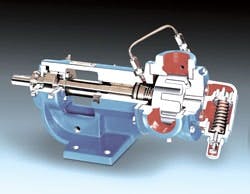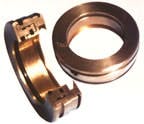It's not an easy thing to do in today's plant environment, but give it a shot. Kick back, put up your heels and think for a moment about the ideal pump. Imagine a strong, new machine smelling of fresh oil and paint, eager to be bolted up and start working on whatever fluid you have to move. Ponder its willingness to be forgotten and abused, yet serve trouble-free for years beyond its anticipated life.
What technological developments would be manifested in this wondrous engine of fluid motivation? Pump guru Bill McNally lists more than 50 specific features he'd seek at http://mcnallyinstitute.com/09-html/9-3.html. He and other experts emphasize high-performance seals, long-lasting bearings and advanced pump designs and materials, all properly matched to the application. Indeed, those are the areas pump-makers have been focusing their product developers on during the past several years. Advanced materials at workThe past few years have witnessed an explosion in the performance and availability of ceramics, polymers, composites, exotic corrosion- and wear-resistant alloys and surface treatments originally developed for cost-is-no-object applications in aerospace, military and semiconductor fabrication. These materials underlie significant increases in maintenance intervals and service lives of many common pump components. Not long ago, titanium was viewed as an unobtainable, exotic material for most industrial applications. Now the fall of the Iron Curtain and advances in refining and manufacturing technology have brought it into the mainstream. "There is plenty of excess worldwide capacity to meet demand," says Rick Porter, corrosion engineer, RMI Titanium, Niles, Ohio. "The Russians have no concept of supply and demand, they just make as much as they can." "Titanium offers unique opportunities for many industrial applications," says Lev Nelik, president, Pumping Machinery (www.pumpingmachinery.com). "Among the highlights are elevated strength-to-density ratio, low densityroughly half the weight of steel, nickel and copper alloyswhich translates into significantly improved dynamics of titanium rotors, exceptional corrosion resistance excellent elevated temperature properties (up to 600F) and excellent properties at low temperatureASME allows using of Titanium Grade 1 and Grade 2 to -75F." Where abrasion-resistant alloys and surface treatments were once reserved for rotating parts, Viking Pump, for example, now offers three hardened material options for high-wear stationary components on its abrasive liquid pumps (see Figure 1). New material options include hardened cast iron, austempered ductile iron and tungsten carbide-coated cast iron. Service life on highly abrasive liquids has been extended by more than 50%.
|
View related content on PlantServices.com |
Figure 1: Hard case In abrasive service pumps, wear-resistant materials once reserved for rotating parts are now being used for stationary components as well. But most experts identify seals and bearings as the traditional limiting components when it comes to pump life and maintenance, and those areas are where advanced materials are making the most significant improvements. Long live the seals
Process-pump sealing technologies continue to move from wet/contacting to dry-running designs. "Dry-running, non-contacting gas seals, common in compressors and turbines, are becoming more standard in process pump and slower-shaft-speed applications such as mixers," says Mike Kraus, market development manager, John Crane Inc. (www.johncrane.com).In traditional seals, mating faces run against each other, resulting in friction and wear and requiring lubrication. Non-contact seals are designed with an engineered pattern on the face so one surface lifts off from the other. Air or gas forms the seal. Friction and its associated wear and heat are significantly reduced, which extends seal life for longer maintenance intervals.These seals are effective even for highly regulated or hazardous fluids. "We continue to have increasing success using high-pressure gas seals and nitrogen gas to seal hazardous materials," says Tom Bennett, marketing manager, Flowserve (www.flowserve.com). "This approach increases mean time between failure and helps us reach our goal, which is to save customers downtime."For dry-running seals, where faces are in contact and there is no fluid for lubrication, there are new materials and designs that reduce heat and wear. Some offer improved wear resistance for both wet and dry running and for unloading operations, for example, where there may be nobody there to turn off the pump when the freight car or tank is emptied.In one example, the traditional soft face/hard face combination (i.e. carbon graphite/silicon carbide) is being replaced with designs where both faces are made of the same silicon carbon/graphite composite, which combines the lubricity of carbon graphite with the wear resistance of silicon graphite. The result is a seal with improved abrasion resistance and dry-running capabilities.In another application, seals made of a sintered composite of silicon carbide and graphite were able to withstand five hours of dry running on an agricultural chemical pump. "Over 100,000 pairs of seals based on this new material have been supplied for the past two seasons for many tough applications, including trailer-mounted pumps," says Joseph Boylan, vice president, market engineering, Morgan AM&T (www.mamat.com). "And, according to the users, not one seal has yet failed," he adds.More cartridges
Progress is particularly concentrated in seal cartridges. "A seal is only as good as the alignment and installation, and companies these days have lost a lot of the experienced mechanics who can properly install multi-component seals that have to be aligned within thousandths of an inch," Kraus says. "It's become important for us to simplify installation and minimize the chance of error. With a cartridge, you slide it into position, tighten it up, and you're ready to go."Factory-assembled cartridges can be preassembled, pressurized and tested for loss under simulated operating conditions. Seals that are field-assembled from components can't be fully tested until they're installed on the equipment, when any problems can cause an expensive extended shutdown or emergency repair.Preassembly in cartridges eliminates handling damage such as fingerprints and tiny scratches on O-rings and lapped surfaces that can reduce seal life. "Our most advanced technology goes into our cartridge seals," Kraus adds. "They can have higher numbers of more complex parts. To expect the end user to put them together would be inappropriate."Cartridges can last longer due to more precise alignment, proper seal setting and better materials. They can more than recoup their higher initial cost with fewer startup failures and more uniform service lives. "At, on average, $2,000 to $3,000 in maintenance cost per changeout of a seal that costs less than $1,000, it makes sense to use a cartridge that should last 36 months instead of six to 12 months or less for an incorrectly installed, site-assembled seal," Kraus says. Way better bearings
The same corrosion and wear-resistant properties that make carbide-graphite composite seals last longer are improving the performance of sliding-element bearings, giving them critical resistance to abrasive fluids and run-dry conditions (see Figure 2)."Vibration-prone applications, such as pumps with mechanical seals, can benefit from these bearings because their running clearances can be made tighter than those for other bearing materials," says Eben Walker, general manager, Graphite Metallizing (www.graphalloy.com). "The coefficient of expansion of these materials is about half that of steel, so shaft clearances are typically in the range of 0.008 in. to 0.012 in., less than one-third of those required for metallic parts. In fluid-handling systems, this has the added benefit of less leakage and greater efficiency."
Process-pump sealing technologies continue to move from wet/contacting to dry-running designs. "Dry-running, non-contacting gas seals, common in compressors and turbines, are becoming more standard in process pump and slower-shaft-speed applications such as mixers," says Mike Kraus, market development manager, John Crane Inc. (www.johncrane.com).In traditional seals, mating faces run against each other, resulting in friction and wear and requiring lubrication. Non-contact seals are designed with an engineered pattern on the face so one surface lifts off from the other. Air or gas forms the seal. Friction and its associated wear and heat are significantly reduced, which extends seal life for longer maintenance intervals.These seals are effective even for highly regulated or hazardous fluids. "We continue to have increasing success using high-pressure gas seals and nitrogen gas to seal hazardous materials," says Tom Bennett, marketing manager, Flowserve (www.flowserve.com). "This approach increases mean time between failure and helps us reach our goal, which is to save customers downtime."For dry-running seals, where faces are in contact and there is no fluid for lubrication, there are new materials and designs that reduce heat and wear. Some offer improved wear resistance for both wet and dry running and for unloading operations, for example, where there may be nobody there to turn off the pump when the freight car or tank is emptied.In one example, the traditional soft face/hard face combination (i.e. carbon graphite/silicon carbide) is being replaced with designs where both faces are made of the same silicon carbon/graphite composite, which combines the lubricity of carbon graphite with the wear resistance of silicon graphite. The result is a seal with improved abrasion resistance and dry-running capabilities.In another application, seals made of a sintered composite of silicon carbide and graphite were able to withstand five hours of dry running on an agricultural chemical pump. "Over 100,000 pairs of seals based on this new material have been supplied for the past two seasons for many tough applications, including trailer-mounted pumps," says Joseph Boylan, vice president, market engineering, Morgan AM&T (www.mamat.com). "And, according to the users, not one seal has yet failed," he adds.More cartridges
Progress is particularly concentrated in seal cartridges. "A seal is only as good as the alignment and installation, and companies these days have lost a lot of the experienced mechanics who can properly install multi-component seals that have to be aligned within thousandths of an inch," Kraus says. "It's become important for us to simplify installation and minimize the chance of error. With a cartridge, you slide it into position, tighten it up, and you're ready to go."Factory-assembled cartridges can be preassembled, pressurized and tested for loss under simulated operating conditions. Seals that are field-assembled from components can't be fully tested until they're installed on the equipment, when any problems can cause an expensive extended shutdown or emergency repair.Preassembly in cartridges eliminates handling damage such as fingerprints and tiny scratches on O-rings and lapped surfaces that can reduce seal life. "Our most advanced technology goes into our cartridge seals," Kraus adds. "They can have higher numbers of more complex parts. To expect the end user to put them together would be inappropriate."Cartridges can last longer due to more precise alignment, proper seal setting and better materials. They can more than recoup their higher initial cost with fewer startup failures and more uniform service lives. "At, on average, $2,000 to $3,000 in maintenance cost per changeout of a seal that costs less than $1,000, it makes sense to use a cartridge that should last 36 months instead of six to 12 months or less for an incorrectly installed, site-assembled seal," Kraus says. Way better bearings
The same corrosion and wear-resistant properties that make carbide-graphite composite seals last longer are improving the performance of sliding-element bearings, giving them critical resistance to abrasive fluids and run-dry conditions (see Figure 2)."Vibration-prone applications, such as pumps with mechanical seals, can benefit from these bearings because their running clearances can be made tighter than those for other bearing materials," says Eben Walker, general manager, Graphite Metallizing (www.graphalloy.com). "The coefficient of expansion of these materials is about half that of steel, so shaft clearances are typically in the range of 0.008 in. to 0.012 in., less than one-third of those required for metallic parts. In fluid-handling systems, this has the added benefit of less leakage and greater efficiency."
Figure 2: Run dryMetallic (left) and graphite-matrix pump bearings were run dry for the same period of time. The graphite in the bearing serves as a fail-safe lubricant until fluid is reintroduced--in some cases, for more than 50 hours.Non-metallic, ceramic and especially hybrid bearings (metal races and retainers with ceramic rolling elements) also are moving into pumps. Developed for their resistance to welding up in the deep vacuum of outer space, ceramic bearing ball costs have been brought down by widespread use in machine tools for their high-RPM capabilities, then in motors to insulate against stray-current damage. Now they're coming to price-conscious applications, where their low heat generation eases stresses on lubricants."We're now trying to find out how to make bearings last longer when pumps are abused," says Dave Mikalonis, global program manager, SKF (www.skfusa.com). "Operations is pushing for more output and more time between shutdowns, and engineers are sitting on the sidelines saying, 'My God, you're ruining my pump!'"Combined with improved seals that keep dirt and contaminants out and generate less heat, cool-running bearings are extending the lives of conventional lubricants and increasing the range of maintenance-free applications.Ceramic balls allow longer oil change intervals or, where process temperatures are low enough to not require oil cooling, grease instead of oil lubrication. "Eighty percent of oil-lubed pumps still need oil because of the process," says Mikalonis, "but now more can be grease-lubed."While re-greasing is still the norm, more applications are being sealed and grease-lubricated for lives of five to 10 or more years.Bearing life is inextricably intertwined with seal effectiveness. Pump makers are recognizing this and demanding more from seals. For example, Goulds is now offering Inpro bearing isolators as standard equipment on ANSI Model 3196 pumps. The two-part isolators consist of a stator press-fitted into the bearing housing and a rotor attached to the shaft (see Figure 3).
Figure 3: Put bearings in isolation
Bearing isolators wear longer and do a better job of keeping lubricants in and contaminants out, in some cases halving maintenance and doubling mean time between failures.The company claims the isolators more than double mean time between failure. It says protected bearings have run 50,000 hours (5.7 years) or more, and running the bearings under optimal conditions can let pumps last five to 10 times longer.Data, data, data
There's no way to complete an article on technology trends in industrial equipment, pumps or otherwise, without acknowledging advances in sensor technology, data acquisition and data processing that fuel predictive and reliability-centered maintenance, and pumps are seeing their share.Pump vendors agree that condition monitoring is becoming a must. "Intelligent pumping systems with embedded sensors and controls provide for smoother startups and production changes, tighter control during continuous operation and faster diagnosis of system problems," says Mike Pemberton, manager, business development and marketing, ITT PumpSmart Control Solutions (www.gouldspumps.com). "[This is] before product quality or process operation is negatively affected," he says.Plants are doing more online condition monitoring, often by cooperating or contracting with equipment vendors. "Our condition datapoint monitoring service monitors each covered piece of equipment for vibration, temperature, pressure, flow and other target points," says Flowserve's Bennett. "By following trends and doing predictive maintenance, we can take action before a failure.""High reliability and availability are the primary customer requirements modern pump suppliers are confronted with," says Nils Kohlhase, manager, research and development, Lewa (www.lewa.com). "Monitoring systems can make a decisive contribution."
Bearing isolators wear longer and do a better job of keeping lubricants in and contaminants out, in some cases halving maintenance and doubling mean time between failures.The company claims the isolators more than double mean time between failure. It says protected bearings have run 50,000 hours (5.7 years) or more, and running the bearings under optimal conditions can let pumps last five to 10 times longer.Data, data, data
There's no way to complete an article on technology trends in industrial equipment, pumps or otherwise, without acknowledging advances in sensor technology, data acquisition and data processing that fuel predictive and reliability-centered maintenance, and pumps are seeing their share.Pump vendors agree that condition monitoring is becoming a must. "Intelligent pumping systems with embedded sensors and controls provide for smoother startups and production changes, tighter control during continuous operation and faster diagnosis of system problems," says Mike Pemberton, manager, business development and marketing, ITT PumpSmart Control Solutions (www.gouldspumps.com). "[This is] before product quality or process operation is negatively affected," he says.Plants are doing more online condition monitoring, often by cooperating or contracting with equipment vendors. "Our condition datapoint monitoring service monitors each covered piece of equipment for vibration, temperature, pressure, flow and other target points," says Flowserve's Bennett. "By following trends and doing predictive maintenance, we can take action before a failure.""High reliability and availability are the primary customer requirements modern pump suppliers are confronted with," says Nils Kohlhase, manager, research and development, Lewa (www.lewa.com). "Monitoring systems can make a decisive contribution."
Sponsored Recommendations
Sponsored Recommendations
April 14, 2025
April 14, 2025
April 14, 2025



